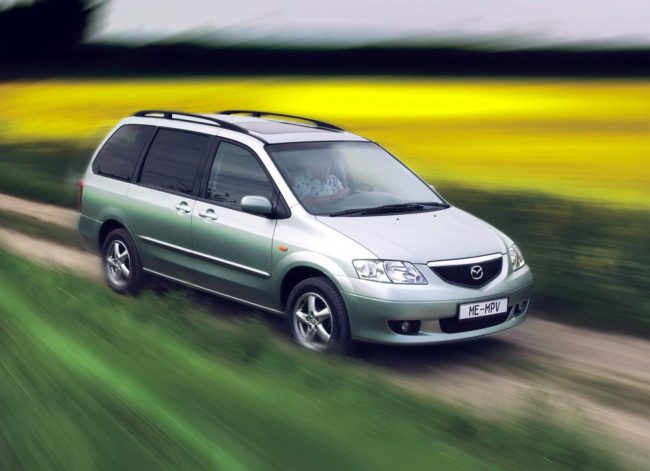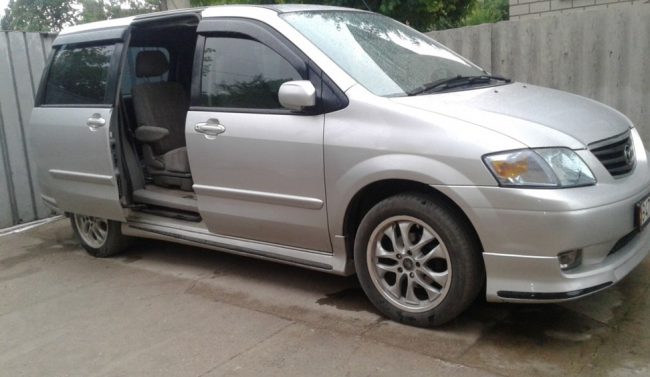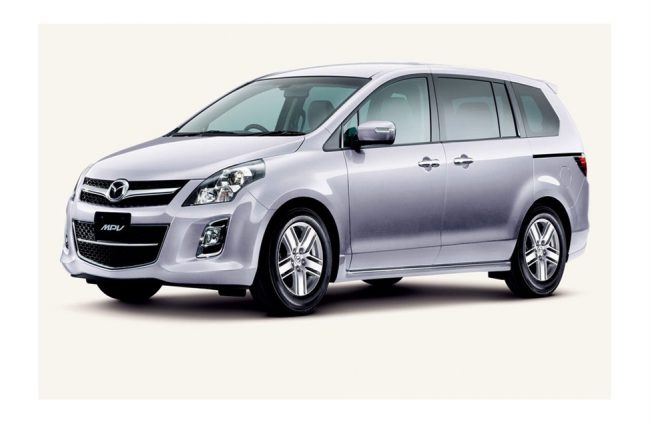
Mazda MPV engines
Content
The Mazda MPV (Multi Purpose Vehicle) is a minivan manufactured by Mazda. Designed in 1988 and introduced in the same year as a rear-wheel drive model with a choice of all-wheel drive. Serial production of the first generation - 1989-1999.

General characteristics:
- 4-door van (1988-1995)
- 5-door van (1995-1998)
Front engine, rear wheel drive / four wheel drive
Mazda LV platform
Power unit:
- engine
- 2,6L G6 I4 (1988-1996)
- 2,5L G5 I4 (1995-1999)
- 3,0 л JE V6
broadcast
- 4-speed automatic
- 5-speed manual
Dimensions:
- Wheelbase 2804 mm (110,4″)
- Length 1988-1994: 4465 mm (175,8″)
- 1995-98: 4661 mm (183,5″)
Width 1826 mm (71,9″)
- 1991-95 and 4WD: 1836mm (72,3″)
Height 1988-1992 & 1995-98 2WD: 1730 mm (68,1″)
- 1991-92 and 4WD: 1798mm (70,8″)
- 1992-94: 1694 mm (66,7″)
- 1992-94 4WD: 1763mm (69,4″)
- 1995-97 and 4WD: 1798mm (70,8″)
- 1998 2WD: 1750 mm (68,9″)
- 1998 4WD: 1816 mm (71,5″)
Curb weight
- 1801 kg (3970 lb).
The MAZDA MPV car was created from scratch as a minivan in 1988. It was delivered for the American car market. Launched in 1989 in Hiroshima at the Mazda plant. The base was a large LV platform, on which it became possible to place a V6 engine and four-wheel drive. The car had the ability to switch to all-wheel drive even while driving.
The minivan entered the TOP-10 in 1990 and 1991. Car and Driver magazine. Was introduced as an economical car for the upcoming fuel crisis.
For the 1993 model line, a new Mazda emblem, remote keyless entry system and a driver's airbag were developed.
In 1996, a rear door and a passenger airbag were added to the car. Mazda stopped production of first generation minivans in 1999. In total, more than 1 million first generation cars were produced. This minivan was replaced in 1999 with a front wheel drive version with optional all wheel drive in some markets.
Second generation (LW; 1999-2006)
 During the years of production, several restylings were made.
During the years of production, several restylings were made.
General characteristics:
- Production 1999-2006
Hull and Chassis
ФормР° РєСѓР · РѕРІР °
- 5 door van
Mazda LW platform
Power unit:
Engine
- 2,0 L FS-DE I4 (99-02)
- 2,3L L3-VE I4 (02-05)
- 2,5L GY-DE V6 (99-01)
- 2,5 l AJ V6 (99-02)
- 3,0 l AJ V6 (02-06)
- 2,0 l turbodiesel of the Russian Federation
Transmission
- 5-speed automatic
Dimensions:
Wheelbase
- 2840 mm (111.8″)
Length 1999-01: 4750 mm (187,0″)
- 2002-03: 4770 mm (187.8″)
- 2004-06: 4813 mm (189,5″)
- 2004-06 LX-SV: 4808 mm (189,3″)
Width 1831 mm (72.1″)
Height 1745 mm (68,7″)
- 1755mm (69,1″) 2004-2006 IS:
Curb weight
- 1,659 kg (3,657 pounds)
In the second generation Mazda MPV, which began to be produced in 2000, a shorter wheelbase, LW front-wheel drive platform, 4WD all-wheel drive were designed. Also, the car was equipped with double sliding rear doors and a third-row seat that can be lowered to the floor, a sports chassis.
At the launch of the second generation Mazda MPV series, a 170-horsepower V6 engine was used, which was installed on the Ford Contour.
Starting in 2002, the second generation minivan was equipped with a Mazda AJ 3,0 liter V6 engine with a capacity of 200 hp. With. (149 kW) and 200 lb*ft (270 N*m) of torque, 5 st. automatic transmission.
Most gasoline engines have the SKYACTIV-G system, which saves fuel, makes the car more manageable, and reduces CO2 emissions. Automatic transmission with this system works faster and more efficiently. There are also other advantages that will be developed in the future in the process of mastering new car models.
In 2006, the production of cars of the second generation was discontinued.
Deliveries of the MPV minivan were discontinued in Europe and North America after the 2006 model year. The MPV was replaced for North America and Australia by the Mazda CX-9 SUV full-size crossover, and for Europe there was a similar replacement with the Mazda 5.
- 2002 Mazda MPV LX (USA)
- 2002-2003 Mazda MPV (Australia)
- 2004-2006 Mazda MPV LX (USA)
- 2005-2006 Mazda MPV LX-SV (USA)
Engines:
- 1999-2002 2,0L FS-DE I4 (Non-US)
- 1999-2001 2,5L GY-DE V6 (Non-US)
- 1999-2002 2,5 l ALSO V6
- 2002-2006 3,0 l ALSO V6
- 2002-2005 2,3L MPO 2,3 direct injection, spark ignition
- 2002-2005 2,0L Turbodiesel I4 (Europe)
In 2005, the Mazda MPV received a poor rating due to side impact testing, which could result in serious injury to the driver and rear passenger.
Third generation (LY; 2006-2018)
Start of production in 2006 and continues to be produced to the present. It is known as the Mazda 8.
Years of production 2006-2018
General characteristics:
ФормР° РєСѓР · РѕРІР °
- 5 door van
Mazda LY platform
Power unit:
Engine
- 2,3L L3-VE I4
- 2,3L L3-VDT turbo I4
Transmission
- 4/5/6-speed automatic
dimensions
Wheelbase
- 2950 mm (116,1″)
Length 4868 mm (191,7″), 2007: 4860 mm (191,3″)
Width 1850 mm (72,8″)
Height 1685 mm (66,3″).
In February 2006, the third generation Mazda MPV went on sale in Japan. The car was powered by either a four-cylinder direct-injection spark-ignition engine with a 2,3-litre naturally aspirated engine, or the same engine but only turbocharged. The gearshift was moved from the steering column to the center console, as in most other Japanese minivans.
The third generation MPV became available only in the countries of East and Southeast Asia - Japan, China, Hong Kong, Macau, Indonesia, Thailand, Malaysia under the Mazda 8 brand. 4WD and Turbo models are available only in the domestic (Japanese) market. Not shipped to North America or Europe.
Engines installed on various generations of cars
| First generation LV | |||||||
| Release period | Engine make | engine's type | Cylinder volume, l | Power, hp | Torque, N * m | Fuel | Fuel consumption, l / 100 km |
| 1989-1994 | G5-E | 4 cylinders in line | 2.5 | 120 | 197 | Gasoline REGULAR (AI-92, AI-95) | 11.9 |
| 1994-1995 | IS-E | V6 | 3 | 155 | 230 | PREMIUM (AI-98), REGULAR (AI-92, AI-95) | 6,2-17,2 |
| 1995-1999 | WL-T | 4 cylinders in line | 2 | 125 | 294 | DT | 11.9 |
| Second generation L.W. | |||||||
| Release period | Engine make | engine's type | Cylinder volume, l | Power, hp | Torque, N * m | Fuel | Fuel consumption, l / 100 km |
| 1999-2002 | GY | V6 | 2.5 | 170 | 207 | Gasoline REGULAR (AI-92, AI-95) | 12 |
| 1999-2002 | GY-DE | V6 | 2.5 | 170 | 207 | Gasoline REGULAR (AI-92, AI-95) | 14 |
| 1999-2002 | FS | 4 cylinders in line | 2 | 135 | 177 | Gasoline REGULAR (AI-92, AI-95) | 10.4 |
| 1999-2002 | FS-DE | 4 cylinders in line | 2 | 135 | 177 | Gasoline PREMIUM (AI-98), Gasoline REGULAR (AI-92, AI-95), Gasoline AI-95 | 4,8-10,4 |
| 2002-2006 | EJ-THEM | V6 | 3 | 197 | 267 | Gasoline REGULAR (AI-92, AI-95) | 11 |
| 2002-2006 | EJ | V6 | 3 | 197-203 | 265 | Gasoline REGULAR (AI-92, AI-95) | 10-12,5 |
| 1999-2002 | L3 | 4 cylinders in line | 2.3 | 141-163 | 207-290 | Gasoline REGULAR (AI-92, AI-95), Gasoline AI-92 | 8,8-10,1 |
| 2002-2006 | L3-DE | 4 cylinders in line | 2.3 | 159-163 | 207 | Gasoline REGULAR (AI-92, AI-95) | 8,6-10,0 |
| Third generation LY | |||||||
| Release period | Engine make | engine's type | Cylinder volume, l | Power, hp | Torque, N * m | Fuel | Fuel consumption, l / 100 km |
| 2006-2018 | L3-VDT | 4 cylinders in line | 2.3 | 150-178 | 152-214 | Petrol PREMIUM (AI-98), Petrol AI-95 | 8,9-11,5 |
| 2006-2018 | L3-VE | 4 cylinders in line | 2.3 | 155 | 230 | Gasoline PREMIUM (AI-98), Gasoline REGULAR (AI-92, AI-95), Gasoline AI-95 | 7,9-13,4 |
Most popular engines
- For the first generation, the most popular gasoline engines were the G5 and JE internal combustion engines (ICE) and the WL-T turbodiesel.
- The second generation was most often completed with GY, FS and L3 engines of various modifications.
- The third generation continued to install L3 engines of various modifications.
Which engine is better to choose a car
Gasoline engines with a volume of 2,5-3,0 liters are popular on the market. Engines with a volume of 2,0-2,3 liters are quoted less. Although they are more economical, these engines do not suit all buyers. That is, the engine simply does not pull the car as the driver would like. Pay attention to the fact that gasoline engines go less beyond the parameters stated in the parameters of the machine. The most important advantage is the reliability of the engine, maintainability, availability of original spare parts. The real Japanese are very quoted.
For the first generation, the G5 engine (4 cylinders, volume 2, l, 120 hp) has proven itself well. But he was weak. A better option turned out to be V-type engines with 6 cylinders. In the second generation, V6 engines of the GY brands (volume 2,5 l, 170 hp), EJ (volume 3,0 l, 200 hp), as well as a 4-cylinder in-line L3 (volume 2,3 l, 163 hp). Petrol engines make it very easy to install LPG equipment. But the trunk will be occupied by a gas cylinder.
Carefully! It is better to refrain from buying used cars with SKYAKTIVE system and mileage over 200000 km. Because the destructive effect of detonation on worn engine parts will be too detrimental to their condition.
Wear and tear will start to increase catastrophically. Breakdowns will happen much more often. As a result, the engine will become unrepairable. Or the cost of its repair will exceed reasonable limits.


Watch this video on YouTube
It is not recommended to purchase a car with a diesel engine for several reasons:
- Diesel requires qualified care and maintenance. Diesel is not in great demand, they try to take it less often. You need to watch the diesel engine more carefully, change components and consumables in time. Diesel loses a lot of power with careless care. Often overheats when using consumables that have expired. In addition, gasoline engines are much more responsive.
- Diesel itself is capricious in operation. The reviews of most owners of diesel cars are still negative. Mainly due to increased fuel consumption.
- A car with a diesel engine is poorly liquid, i.e. when reselling, certain difficulties may arise - it is not so easy to find a buyer.
Basically, buyers pay attention to the cabin, its capacity, the convenience of the location of the driver, passengers (for large families).

